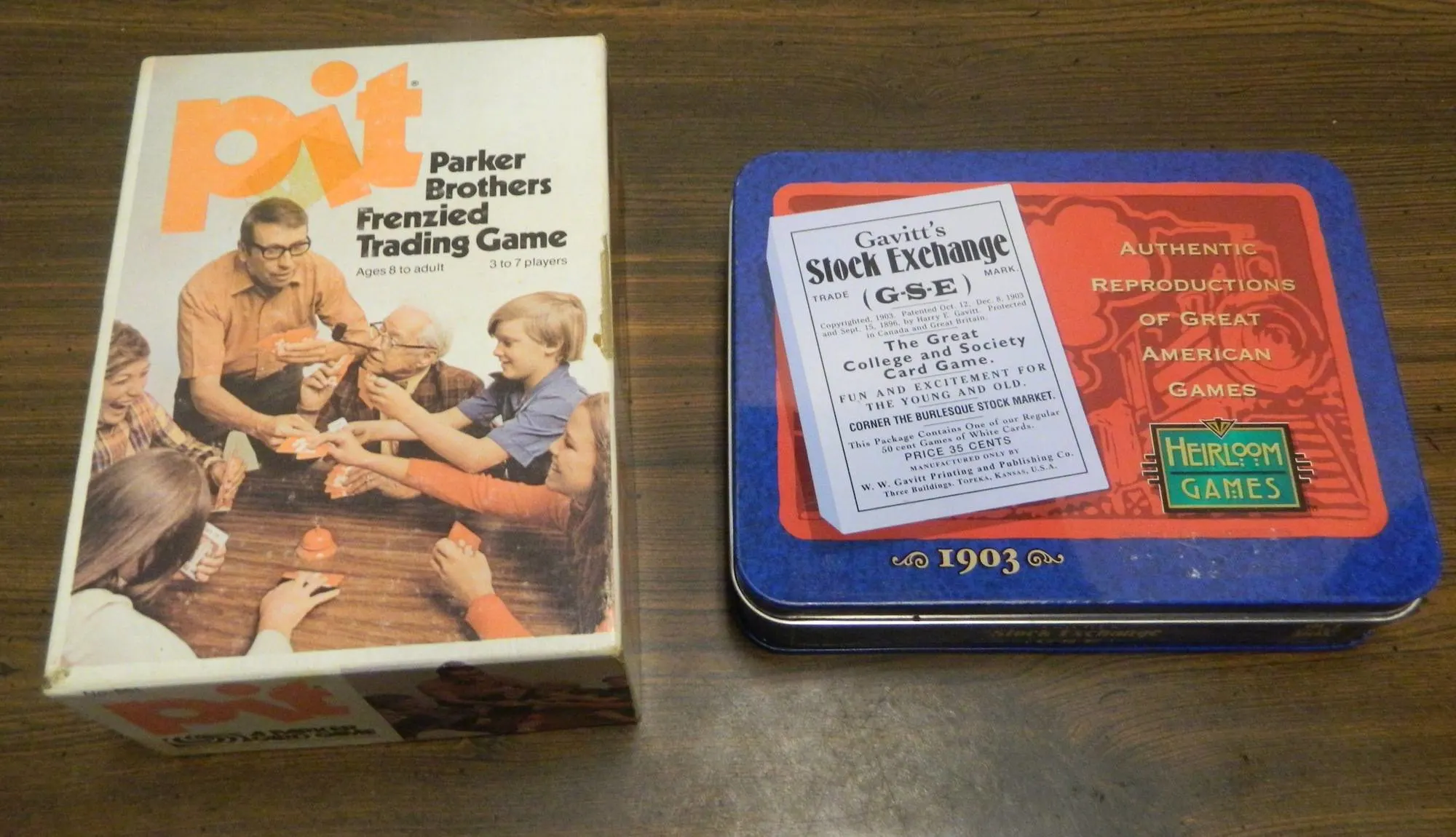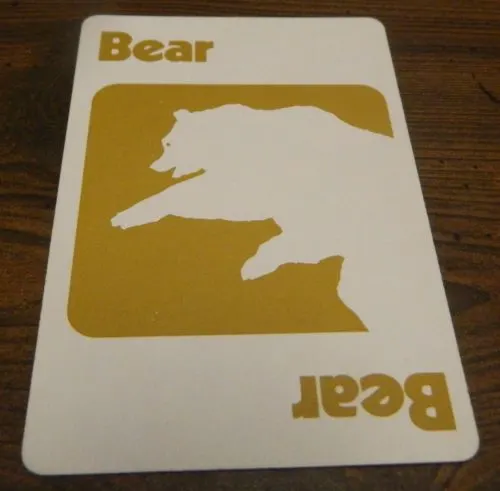When you look at the card games Pit and Gavitt’s Stock Exchange there is a pretty interesting backstory. With Gavitt’s Stock Exchange apparently being patented in 1896 and published in 1903 and Pit also being published in 1903 these two games share a long and interesting history with one another. With both games being released so close to one another and sharing very similar gameplay there have even been accusations that both games have stolen ideas from one another. With the two games sharing so much in common I thought it was appropriate to review both games together. Despite being over 100 years old I have to admit that I had never played either game until recently which is kind of surprising with a game that was popular enough that it is still being made today. While not a great game I have to admit that I was kind of surprised by Pit and Gavitt’s Stock Exchange.
How to Play Pitt and Gavitt’s Stock Exchange
Since both Pit and Gavitt’s Stock Exchange share similar gameplay mechanics, I am going to cover Pit’s rules and then will address the differences with Gavitt’s Stock Exchange.
Setup
For each player in the game include all nine cards for one of the suits. If you are playing the advanced game also include the bull and bear card. Shuffle all of the cards and deal out the cards evenly to all of the players (if you are using the bull and bear card two players will have an extra card). Place the bell in the middle of the table so everyone can reach it.
Playing the Game
After all of the cards have been dealt out, each player has thirty seconds to sort their cards based on suit and decide which strategy they are going to use. The dealer then rings the bell and the game begins. In Pit all of the players will play at the same time.
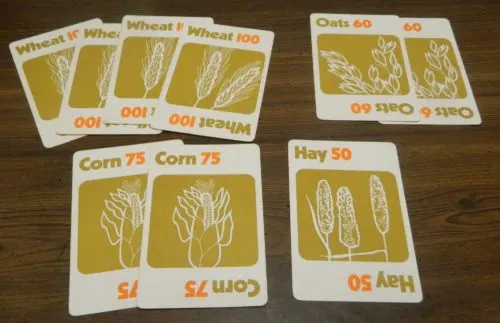
This player has been dealt four wheat, two oats, two corn and one hay for their starting hand. The player will likely want to try and collect the rest of the wheat cards.
In Pit the objective is to get all nine cards of one suit. Unless a player is dealt all of the cards of one suit this means that they will have to trade cards with the other players. Players can trade up to four cards at a time. When trading more than one card at a time all of the cards that are traded have to be of the same suit. All cards are traded face down with the players not telling the other player what suit they are trading.
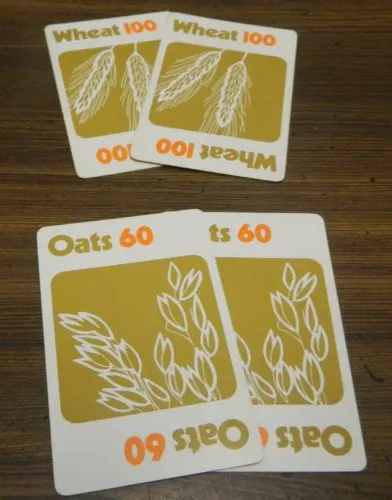
The bottom player has traded two cards of the same type for two cards from the top player. When playing the game these cards would be traded face down.
When one player gets all nine cards of the same suit they ring the bell and declare which suit they collected. If the player has collected all nine cards they will score points equal to the value of the suit they collected. The winner of the round then shuffles all of the cards and deals them out to the players.
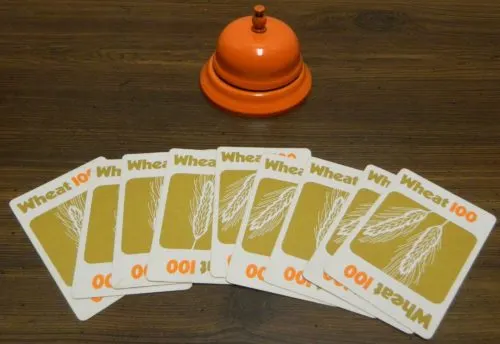
This player has collected all nine wheat cards so they can ring the bell. They will then score 100 points.
Winning the Game
The first player to reach 500 points wins the game.
Bull and Bear Cards
Adding the bear and bull cards to the game slightly tweak how Pit is played. If the bull and bear cards are added there will be an uneven number of cards so two players will get one extra card. Bear and bull cards can be traded like other cards. A bull and/or bear card can be included in a trade with other cards as long as all of the other cards are of the same suit.
The player that is holding a bear card at the end of the round will lose twenty points. If a player is holding a bull card at the end of the round and another player ends the round, the player holding the bull card will lose twenty points.
Unlike the bear card though the player can use the bull card to help them end the round. If a player holds the bull card and eight cards of the same suit, they can end the round. They will score points equal to the value of the suit.
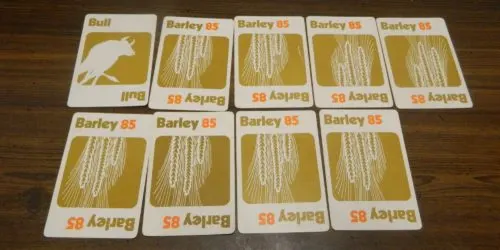
This player has eight barley cards and the bull card. They can end the round and will score 85 points.
If the player collects all nine cards of the same suit along with the bull card, the player can end the round and will score twice the value of the suit.
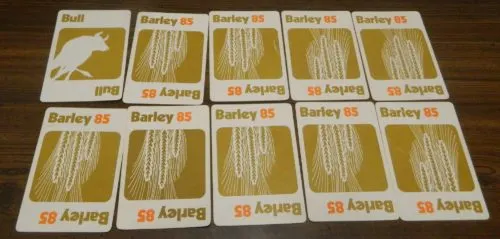
This player has collected all of the barley cards along with the bull card. They can end the round and will score 170 points.
Differences in Gavitt’s Stock Exchange
While not exactly the same as Pit, Gavitt’s Stock Exchange shares enough in common with Pit that it is quicker to note the differences between the two games.
- Each suit has eight cards instead of nine so a player only has to collect eight cards to end the round.
- Players can trade one or two cards at a time instead of four like in Pit.
- Instead of ringing the bell, players have to call out “Topeka” in order to end the round.
- The game ends when a player has earned $1,000.
- The scoring is slightly altered. The player who ended the round will score twice the value of the suit they collected. In addition all players who collected the majority of shares of a company (five cards) will score the value of the suit they collected.
Gavitt’s Stock Exchange also includes a telegram card variation. If the variant is used the dealer will start the round with the telegram card. If the player that holds the telegram card makes a trade, they must pass the telegram card to the player that they traded with (it does not count as one of the cards that were traded). At the end of the round the scoring of the telegram card depends on if the player holding the card ended the round. If the player ended the round, the telegram card reduces the money the player won by $100. If the player holding the card did not end the round though, the player will receive an additional $100.
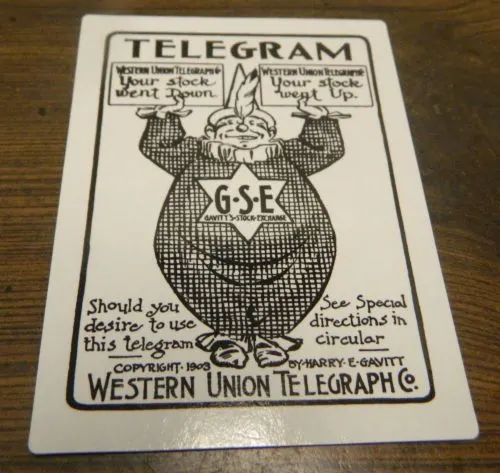
This is the telegram card. If a player holds it at the end of the round and they end the round they will lose $100. If the player does not end the round they will gain $100.
My Thoughts on Pit and Gavitt’s Stock Exchange
So as I have already pointed out this review is going to be a combined review of both Pit and Gavitt’s Stock Exchange. While the two games do have some slight differences which I will address later, the games are too similar that it really doesn’t pay to look at the two games separately. While I didn’t play the card game Billionaire I think most of these comments could also apply to that game as well since it seems to have basically the same mechanics.
Being a game that is over 100 years old and also being a game that you see quite a bit at thrift stores I have to say that I am a little surprised that it took me so long to finally try out Pit. One of the reasons I put off trying the game is that it looked like a very generic set collection game. Basically the goal of the game is to collect all of the cards of one set. Having played a lot of other set collecting games I just wasn’t that interested in trying out another generic set collecting game.
What I found interesting about Pit though is that while the basic set collecting mechanics are present, there is actually more to the game than I first anticipated. This mostly comes from the speed mechanic that is mixed with the set collection mechanic. While there are other set collecting games that have a speed mechanic, I have to give Pit credit for the combination because it was probably the first or at least one of the first games that decided to combine a speed and a set collection mechanic.
For the most part I like the speed mechanic in Pit. While it can at times lead to the game becoming a little chaotic I think it makes Pit a better game. If Pit was just another set collecting game where players traded cards I think the game would have been pretty boring. I have played plenty of other games that have used a similar mechanic. Having to make quick trades because of the speed mechanics though forces players not to over analyze decisions which means the game can move at a pretty brisk pace. While you need to take your time in order to avoid making a bad trade, you need to move quickly or it is likely that another player will complete their set before you complete yours.
With the game relying on speed and set collection mechanics, it should not come as a surprise that the gameplay is a little on the simplistic side. On the positive side with the game being simple you can teach the game to new players pretty quickly. I would guess you could teach the game to most new players within minutes. I also don’t really see any problems with teaching the game to children. The problem with the game being so simple though is that the game relies on quite a bit of luck and doesn’t have a lot of strategy.
Basically your strategy in the game is probably going to be pick the suit that you have the most cards for and then trade away the rest of your cards trying to get the rest of the cards for the suit you are collecting. While you might occasionally change what suit you choose to collect, usually you will just have to keep trading cards hoping that you find your final card before another player finds theirs. The only real strategy I can see in the game is holding back some cards in order to prevent the other players from completing their sets. This will let you control the pace of the game more but you will eventually have to trade them away so I don’t see you having a lot of control over your fate. The more you play the game the better you will probably get at Pit but I think that is mostly due to knowing how best to approach the game which allows you trade quicker. Outside of being somehow able to read what cards the other players have, I think you mostly have to rely on luck being on your side.
In addition to the simple gameplay mechanics the scoring in Pit is also quite easy. Basically whichever player is first to complete a set of cards scores the amount of points that their set is worth. If you use the variant rule some players can also lose twenty points if they hold the bull or bear card. A player can also double their points for a round if they complete their set and hold the bull card. For the most part I like that the scoring is so simple.
The problem that I had with the scoring though is the fact that there is such a significant difference in value for the different suits. I don’t like these different values because collecting a more valuable set than another player mostly comes down to getting dealt more valuable cards. Therefore a player could end up scoring more points than another player just because they were lucky. I am guessing the different values were added to the game in order to impact the trading mechanic. I could see the different values slightly altering what a player would do regarding trades as a player might actually go for a set that is worth more points instead of going for a set that they have more cards for. I don’t think this improves the game enough though to make up for all of the luck that it adds to the game.
While I think most games are best with four players, I have no problem saying that some games are better with more or less players. Usually the reason why games don’t work as well with more players is the fact that more players usually lead to longer games. While this holds true for Pit as well, I actually think Pit is the type of game that would be best with as many players as possible. I think it would be better with more players for a couple reasons. First with more players, more sets of cards are added to the game. Instead of looking through four sets you might have search through six or seven sets of cards to find the cards you are looking for. With there being more sets in the game it is likely that you will be dealt less cards of the same set so you will then have to make more trades in order to complete your set. With more players to trade with I think it provides more opportunities for the players willing to make the most trades. While this might make the game more chaotic I think it will actually improve the game quite a bit.
In addition to the basic game, Pit has a variant rule utilizing the bull and bear cards. While the bull and bear cards were not included in the original game and some of the newer versions of the game, I think the variant rule is intriguing as it adds a decent amount of strategy to the game.
I will start with the bear card which I do not like. The reason I don’t like the bear card is that it is basically used as a card that you try to unload on other players in order to punish them. There are two ways that you can approach the bear card. First you can try to trade it away as quickly as possible. If this strategy is used the card will get passed from player to player until someone finally gets stuck with it at the end. The other option is to hold onto the card for a while and try to time the end of the round so you give the card to another player just before the round ends. This adds a little more strategy since you are taking some risk trying to play the card at the very end so it can’t be passed back to you. Either way though the card just works as a punishment with no benefit. I usually prefer that cards that hurt a player also have a potential beneficial aspect.
This is exactly why I actually really like the bull card. While the bear card can only punish the player that holds it, the bull can hurt the player holding it but could also really help them. The bull card kind of acts as a wild that will hurt you if it is left unused. The bull card can be beneficial since it either lets you collect only eight of the nine cards from your set or gives you a large bonus if you are able to get all nine cards of your suit. This can be quite beneficial as it can either make it easier to end the round or it can help you score more points. If you are unable to use it for either purpose though it counts as negative points. What I like about the bull card is that it seems to strike the right balance between risk and reward.
As I really like part of the variant rule but don’t like the other half, I have mixed feelings about the variant rule as a whole. I wouldn’t ignore the variant rule but it needs to be altered. I think the bull card is fine. The bear card has to either be removed or altered in order to make it more than just a punishment for the player who gets stuck with it. The simplest option might be to just treat the bear card like another bull card. I am wondering if having basically two bull cards would be too much though.
While on the topic of variant rules, Gavitt’s Stock Exchange has its’ own variant rule which is interesting. At first I really liked the idea of the telegram card. What I liked about the card was the fact that it gave players an opportunity to make money even when they weren’t able to win the round. I also liked that it creates a decision for a player if they hold it and otherwise could end the round. This player would either have to take the penalty or try to make a couple trades in order to get rid of it and then get back their complete set.
The problem with the telegram card is that it is really easy to abuse. While I liked the idea that the telegram card lets players score more money if they don’t end the round, this positive has some adverse affects on the game. For example in our game one player had already collected the majority of a company when they got control of the telegram card. Since the set they had already gathered a majority of was pretty valuable they decided to sit out the rest of the round since they would already be making quite a bit of money. While this is a solid strategy it introduces problems because the premise of Gavitt’s Stock Exchange relies on players trading cards. Since this player had cards from other suits they basically blocked the player(s) collecting those suits from having a chance of winning the round. While I like the idea of the telegram card, before I would ever use it again some house rules would need to be implemented to prevent this from happening again.
Although Pit and Gavitt’s Stock Exchange share a lot in common there are some slight differences between the two games.
- Pit has one extra card for each suit. This doesn’t make a huge impact on the game but I prefer Pit because the extra card in each suit tends to lead to a little more trading.
- Pit lets you trade up to four cards at a time while Gavitt’s Stock Exchange only lets you trade two cards. I probably prefer Pit here as well since with only being able to trade up to two cards you will be forced to make a lot of small trades. Pit gives you more flexibility while also letting you change the composition of your hand quicker.
- The biggest change to the actual gameplay is with the scoring. This is an area where I actually prefer Gavitt’s Stock Exchange. In Pit only the player who completes their set scores any points. In Gavitt’s Stock Exchange you get some money for getting the majority of a suit. While this does lead to the winner not getting as much out of winning a round, I think it is offset by not having every round be an all or nothing round.
- Another difference between the two games has to do with the card’s artwork. While I wouldn’t say that Pit’s artwork is good, it is significantly better than Gavitt’s Stock Exchange. This comparison is between the 1973 edition of Pit and the 2003 version of Gavitt’s Stock Exchange. While I can see that the Gavitt’s Stock Exchange game was trying to replicate the original game’s cards, I don’t think it benefits the game itself. The problem with the cards is the fact that the cards are not as easy to distinguish since the only differences between the cards are the words printed on the cards. When you are playing a speed game you don’t want to waste time reading what is printed on the cards. At least Pit has different pictures on the cards which makes them considerably easier to differentiate.
- While Pit has the variant rule utilizing the bull and bear, Gavitt’s Stock Exchange has the telegram card. As I have already mentioned there are things that I like and don’t like about both variant rules.
When looking at all of these differences I have to say that I personally prefer Pit over Gavitt’s Stock Exchange. While both games have elements that are better and worse than the other game, I prefer Pit because it would actually be quite easy to implement the things I prefer about Gavitt’s Stock Exchange into Pit. The scoring system from Gavitt’s Stock Exchange could easily be implemented into Pit with a slight tweak to the rules. The telegram card could also be implemented if you wanted by using anything to represent the telegram card as it is just passed from player to player. The things I prefer about Pit though would be much harder to implement into Gavitt’s Stock Exchange.
With Pit being such a popular game it is kind of hard to really talk about the components of the game. Since I only have the 1973 version of Pit and the 2003 edition of Gavitt’s Stock Exchange I can really only talk about these two versions. As I have already mentioned I prefer Pit because the cards were easier to distinguish from one another. I wouldn’t say that the cards are great for the 1973 version of Pit though since the artwork is pretty basic. One thing that I did appreciate though was the bell since while it doesn’t change the gameplay I think it adds a nice touch to the game. The problem is that most versions of the game don’t include the bell. Outside of the older and deluxe versions of the game, most copies of Pit don’t come with the bell.
Should You Buy Pit or Gavitt’s Stock Exchange?
With Pit and Gavitt’s Stock Exchange being over 100 years old I have to admit that I didn’t have high expectations for the games. I was a little surprised after playing the games though. They are far from a great game but they are pretty good for such old games. I think the combination of the speed and set collection mechanics make for a fun game. With the gameplay being so simple the game works pretty well with children and people who don’t play a lot of card games. This simplicity also leads to quite a bit of luck though as the cards you are dealt are going to have a pretty big impact on whether you are going to win the game. I think the addition of the variant rules improve the games in some ways but I think they could be tweaked as well.
Of the two games I personally would prefer Pit over Gavitt’s Stock Exchange. While Gavitt’s Stock Exchange is better than Pit in some ways, these changes could easily be implemented into Pit so you can take advantage of the positives of both games. If you don’t really care for set collection or speed games I don’t think you will care for either game. If you like the idea of combining a speed and set collection game though and don’t mind that the game relies on quite a bit of luck I think you will enjoy Pit and Gavitt’s Stock Exchange. I would recommend picking up Pit but if you can find Gavitt’s Stock Exchange for really cheap it might be worth picking up if you don’t already own Pit.
If you would like to purchase Pit or Gavitt’s Stock Exchange you can find them online: Pit on Amazon, Gavitt’s Stock Exchange on Amazon, Pit on eBay
, Gavitt’s Stock Exchange on eBay

